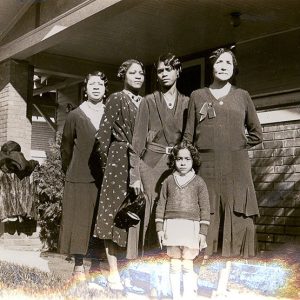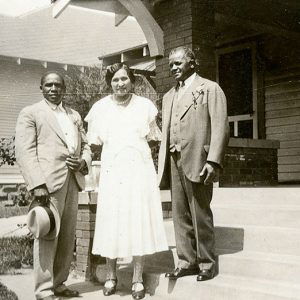calsfoundation@cals.org
Mary Lee McCrary Ray (1880?–1934)
Mary L. Ray spent thirty-seven years educating African Americans. She applied the self-help approach she learned at the Tuskegee Institute to formal education in private and public schools, and then in informal education as the first African-American female employee of the “Negro” division of the Arkansas Agricultural Extension Service—that is, the first black home demonstration agent in the state.
Mary Lee McCrary’s birth year and early life remain a mystery. During the late nineteenth century, as African Americans faced increased assaults to their civil liberties, many turned to capitalism, another American ideal, as visible evidence of citizenship. McCrary apparently embraced this approach. She learned the self-help philosophy from one of the most celebrated advocates of the approach, Booker T. Washington, during four years of instruction at Tuskegee, between 1893 and 1897. She earned certificates in cooking and dress making from Tuskegee in 1897 and subsequently taught in private schools in Alabama and South Carolina. McCrary’s lessons emphasized economic initiative, which took the form of private business development including dress shops and family farms.
McCrary’s years at Tuskegee coincided with expansion of publicly funded higher education for rural African Americans across the South. Some critics labeled it “education for a new slavery,” recognizing the racist thinking that legitimized it, but McCrary and others considered it training for capitalist economic activism. She spent the following thirty-seven years furthering that philosophy. Her professional status meant that she shared responsibilities for launching domestic science education with only a handful of other college-educated black women during the 1910s. Yet, her experiences attest to the personal sacrifices she made to accomplish her goals. She had to leverage local African-American support without incurring the wrath of local whites. Furthermore, private funds, often donated by non-local wealthy whites, could not “buy” local support. This required skillful negotiations, some of which affected local and state politics. Locally elected officials at the county and state level could support projects through appropriation, even if funding proved inadequate.
McCrary transitioned from private to public education in 1900. She became the first instructor of girls in what was called domestic economy at the new Colored Agricultural and Normal University in Langston, Oklahoma Territory, located in a black-separatist community described by its founder as “the Only Distinctively Negro City in America.” Faculty at the Colored Agricultural and Normal University (later Langston University) engaged with the local community at many levels, helping to develop the economic infrastructure in the growing community. By 1906, McCrary operated a dressmaking business, described as “prosperous” by journalists. She likely employed girls who had excelled in her dressmaking courses and who hoped to stay in or near their homes while furthering their careers.
McCrary left Oklahoma after more than fifteen years of service. She married Harvey Cincinnatus Ray, a co-worker at Langston who became the first black employee of the Arkansas Agriculture Extension Service. By early 1916, they had relocated to Arkansas, taking up residency at 2111 Cross Street in Little Rock (Pulaski County).
Mary Ray transferred her experiences with formal classroom instruction and community uplift to reach rural children and adults throughout Arkansas, but especially in Pulaski County and in the Delta counties of Phillips and St. Francis. She emphasized knowledge and skills that progressive reformers believed would make rural families better farmers. These included financial management and techniques to improve health and nutrition and to stabilize farm economies. She involved women and children in group activities that modeled civic engagement. The club work that resulted required setting agendas, holding regular meetings, and maintaining a visible role in community development. Ultimately, Ray leveraged for local support in the form of financial appropriations from county quorum courts. These funds matched state and national monies that paid extension service employees, including home demonstration agents, and that also supported new initiatives such as movable schools. Ray undertook these initiatives in Arkansas using strategies learned at Tuskegee and during her years teaching in underfunded private schools.
Ray’s promotion to Local District Home Demonstration Agent for Extension Work, Negro, on July 1, 1918, expanded her responsibility to as many counties as emergency wartime funding would support—at least thirty based on her 1918 report. She continued in her supervisory position for eighteen years. Her programs focused on economic self-sufficiency and cultural and social support, and she relied on African-American constituents with some economic clout, usually farm owners, to help her accomplish her goals. During the 1920s and early 1930s, she continued this work through programs designed to improve nutrition and diversify farm income. Projects included garden clubs, canning demonstrations, poultry demonstrations, and school lunch programs. These programs helped families, but they did not overtly challenge white supremacy.
Ray and her husband lived in Little Rock, the state capital, rather than Pine Bluff (Jefferson County), the center of public higher education for Arkansas’s African-American population. The Branch Normal School in Arkansas (now the University of Arkansas at Pine Bluff) was Arkansas’s 1890 land-grant institution and the official headquarters of the Negro Division of the Arkansas Agricultural Extension Service. Both Mary and Harvey Ray bore responsibility for extension programs in Phillips County, the site of the Elaine Massacre of 1919, but maintaining their civil servant positions precluded taking political stands or becoming activists.
The stress of her state-wide professional responsibilities likely took a toll on her health, and Ray died of debilitating chronic interstitial nephritis, also known as granular kidney, and arteriosclerosis, on July 25, 1934. After her death, Harvey Ray married another Tuskegee graduate and home demonstration professional, Julia Ada Miller, a native of Round Lake, Mississippi. The couple remained in the home Mary and Harvey had occupied in Little Rock, and they had three children, one of whom, Gloria Ray, became a member of the Little Rock Nine.
For additional information:
Jones-Branch, Cherisse. Better Living by Their Own Bootstraps: Black Women’s Activism in Rural Arkansas, 1914–1965. Fayetteville: University of Arkansas Press, 2021.
Reid, Debra A. “Mary L. Ray (1880?–1934): Arkansas’s Negro Extension Worker.” In Arkansas Women: Their Lives and Times, edited by Cherisse Jones-Branch and Gary T. Edwards. Athens: University of Georgia Press, 2018.
Debra A. Reid
The Henry Ford
 Agriculture
Agriculture Early Twentieth Century, 1901 through 1940
Early Twentieth Century, 1901 through 1940 Home Demonstration Agents
Home Demonstration Agents  Home Demonstration Agents
Home Demonstration Agents 



Comments
No comments on this entry yet.